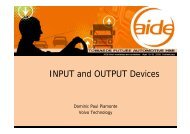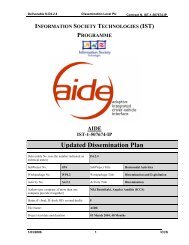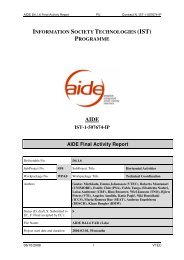download deliverable - AIDE
download deliverable - AIDE
download deliverable - AIDE
You also want an ePaper? Increase the reach of your titles
YUMPU automatically turns print PDFs into web optimized ePapers that Google loves.
Deliverable D4.2.1 Dissemination Level PU Contract N. IST-1-507674-IP<br />
• PDT;<br />
• Occlusion;<br />
• Lane Change Test;<br />
• Driving Simulators;<br />
• Equipped cars, field tests.<br />
Towards a next generation of evaluation methodology the following challenges have been<br />
pointed out:<br />
• Qualify existing methods for the evaluation of integrated and adaptive solutions.<br />
• User Adaptation requires long term aspects during evaluations.<br />
• Situation Adaptation requires complex evaluation scenarios.<br />
• Integrated Solutions require complex evaluation settings.<br />
• Provoke interactions between experimental treatments.<br />
Development of evaluation methodology within <strong>AIDE</strong> is the task of Subproject 2. While<br />
SP1 will identify and model the behavioural effects of IVIS and ADAS functions, the<br />
objective of SP2 is to develop a cost efficient and industrially applicable methodology for<br />
quantifying these effects and their relation to road safety. An important goal is to extend<br />
existing approaches in order to account for new adaptive integrated interface solutions, new<br />
ADAS and nomad devices. Moreover, the methods and tools developed will be linked to<br />
design guidelines and standards (in particular the European Statement of Principles).<br />
3.4. Driver-Vehicle-Environment modelling in <strong>AIDE</strong> within Sub-project 1 (Behavioural<br />
Effects and Driver-Vehicle-Environment Modelling)<br />
Presenter: Pietro Carlo Cacciabue, JRC.<br />
3.4.1. Objectives and Planned activity<br />
The general objective of this sub-project is to develop a basic understanding of the<br />
DVE interaction and the behavioural effects of IVIS and ADAS and develop this into a model<br />
and computer simulation for predicting these effects. The sub-project will also develop the<br />
general conceptual framework to be used throughout the project, including the definition of<br />
taxonomies for IVIS/ADAS functions and their behavioural effects.<br />
SP1 involves two major areas of work: modelling and simulation of the driver-vehicleenvironment<br />
system (WP 1 and 2); and Studies on the behavioural effects of driver assistance<br />
systems and (WP 3).<br />
The general goal of the behavioural studies is to identify the basic mechanisms and<br />
critical parameters underlying behavioural effects of driver assistance and information<br />
functions. The main focus will be on the effects of ADAS, e.g. behavioural adaptation, as this<br />
is where research is most urgently needed. Work will involve simulator studies as well as<br />
field operational tests.<br />
On the basis of the empirical results, a model of the DVE interaction will be<br />
developed. This model will be a key input to the <strong>AIDE</strong> design and development in SP3 as<br />
well as to the methodological development in SP2.<br />
25/07/2005 16 ICCS







